2016 NISSAN NV200 engine filter
[x] Cancel search: engine filterPage 288 of 312
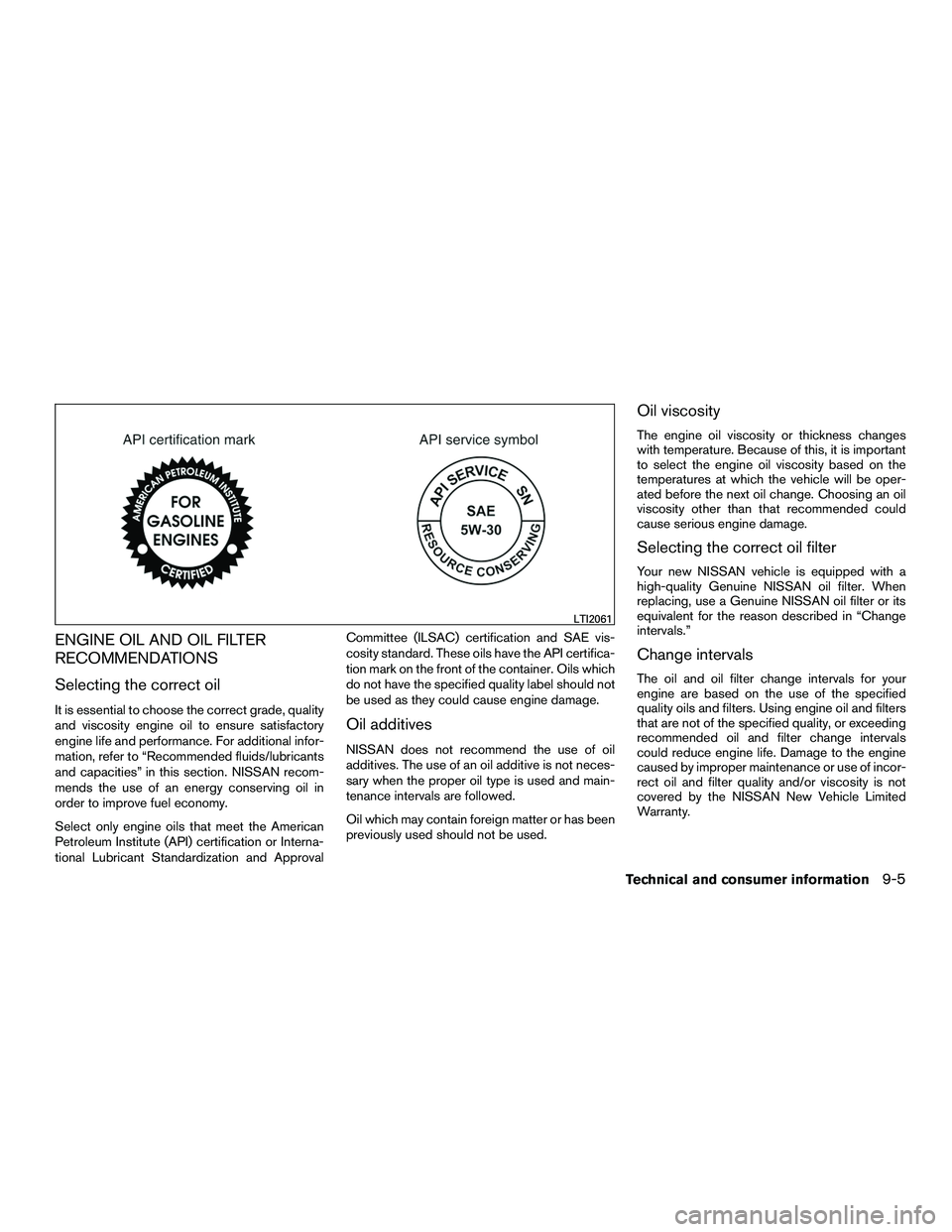
ENGINE OIL AND OIL FILTER
RECOMMENDATIONS
Selecting the correct oil
It is essential to choose the correct grade, quality
and viscosity engine oil to ensure satisfactory
engine life and performance. For additional infor-
mation, refer to “Recommended fluids/lubricants
and capacities” in this section. NISSAN recom-
mends the use of an energy conserving oil in
order to improve fuel economy.
Select only engine oils that meet the American
Petroleum Institute (API) certification or Interna-
tional Lubricant Standardization and ApprovalCommittee (ILSAC) certification and SAE vis-
cosity standard. These oils have the API certifica-
tion mark on the front of the container. Oils which
do not have the specified quality label should not
be used as they could cause engine damage.Oil additives
NISSAN does not recommend the use of oil
additives. The use of an oil additive is not neces-
sary when the proper oil type is used and main-
tenance intervals are followed.
Oil which may contain foreign matter or has been
previously used should not be used.
Oil viscosity
The engine oil viscosity or thickness changes
with temperature. Because of this, it is important
to select the engine oil viscosity based on the
temperatures at which the vehicle will be oper-
ated before the next oil change. Choosing an oil
viscosity other than that recommended could
cause serious engine damage.
Selecting the correct oil filter
Your new NISSAN vehicle is equipped with a
high-quality Genuine NISSAN oil filter. When
replacing, use a Genuine NISSAN oil filter or its
equivalent for the reason described in “Change
intervals.”
Change intervals
The oil and oil filter change intervals for your
engine are based on the use of the specified
quality oils and filters. Using engine oil and filters
that are not of the specified quality, or exceeding
recommended oil and filter change intervals
could reduce engine life. Damage to the engine
caused by improper maintenance or use of incor-
rect oil and filter quality and/or viscosity is not
covered by the NISSAN New Vehicle Limited
Warranty.
LTI2061
Technical and consumer information9-5
Page 289 of 312
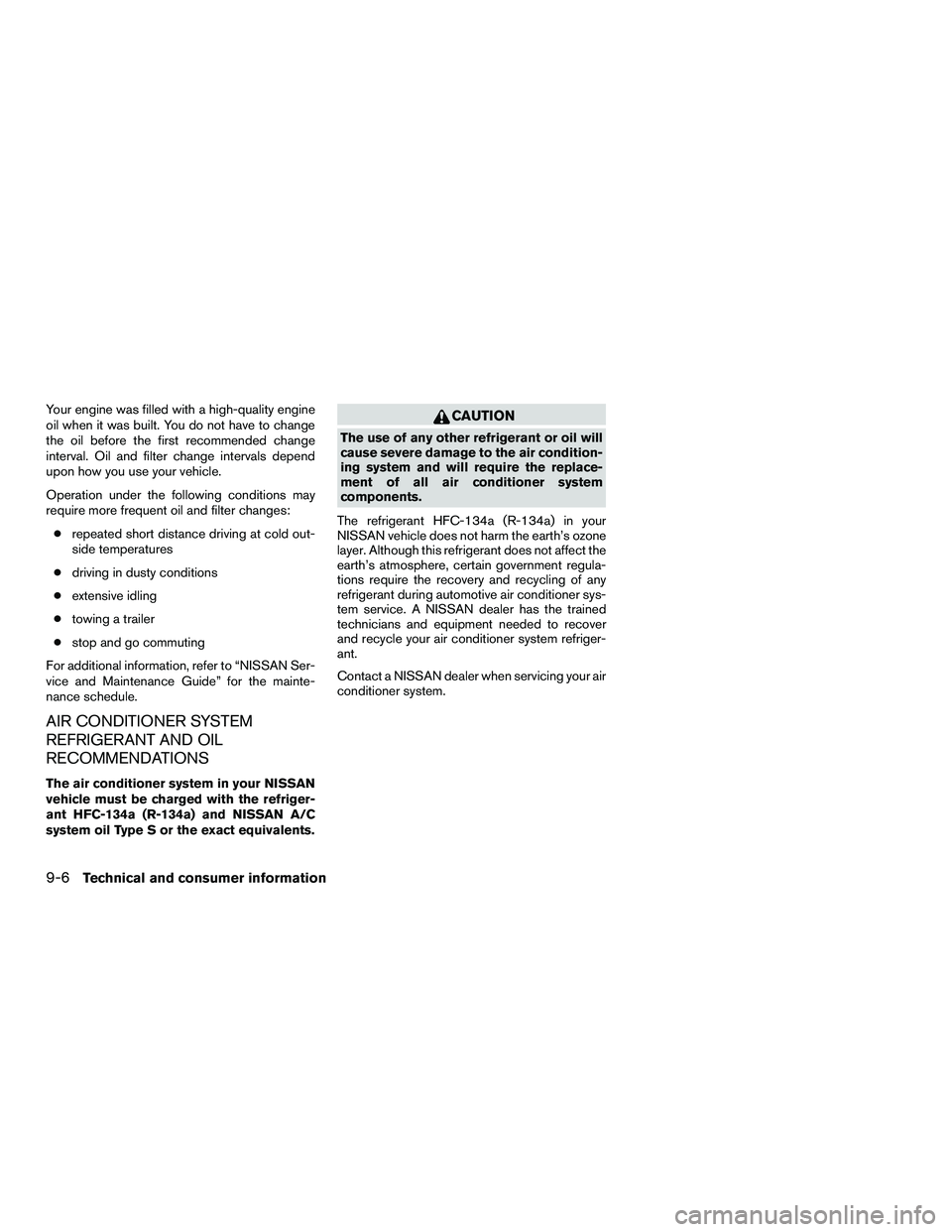
Your engine was filled with a high-quality engine
oil when it was built. You do not have to change
the oil before the first recommended change
interval. Oil and filter change intervals depend
upon how you use your vehicle.
Operation under the following conditions may
require more frequent oil and filter changes:● repeated short distance driving at cold out-
side temperatures
● driving in dusty conditions
● extensive idling
● towing a trailer
● stop and go commuting
For additional information, refer to “NISSAN Ser-
vice and Maintenance Guide” for the mainte-
nance schedule.
AIR CONDITIONER SYSTEM
REFRIGERANT AND OIL
RECOMMENDATIONS
The air conditioner system in your NISSAN
vehicle must be charged with the refriger-
ant HFC-134a (R-134a) and NISSAN A/C
system oil Type S or the exact equivalents.
CAUTION
The use of any other refrigerant or oil will
cause severe damage to the air condition-
ing system and will require the replace-
ment of all air conditioner system
components.
The refrigerant HFC-134a (R-134a) in your
NISSAN vehicle does not harm the earth’s ozone
layer. Although this refrigerant does not affect the
earth’s atmosphere, certain government regula-
tions require the recovery and recycling of any
refrigerant during automotive air conditioner sys-
tem service. A NISSAN dealer has the trained
technicians and equipment needed to recover
and recycle your air conditioner system refriger-
ant.
Contact a NISSAN dealer when servicing your air
conditioner system.
9-6Technical and consumer information
Page 304 of 312
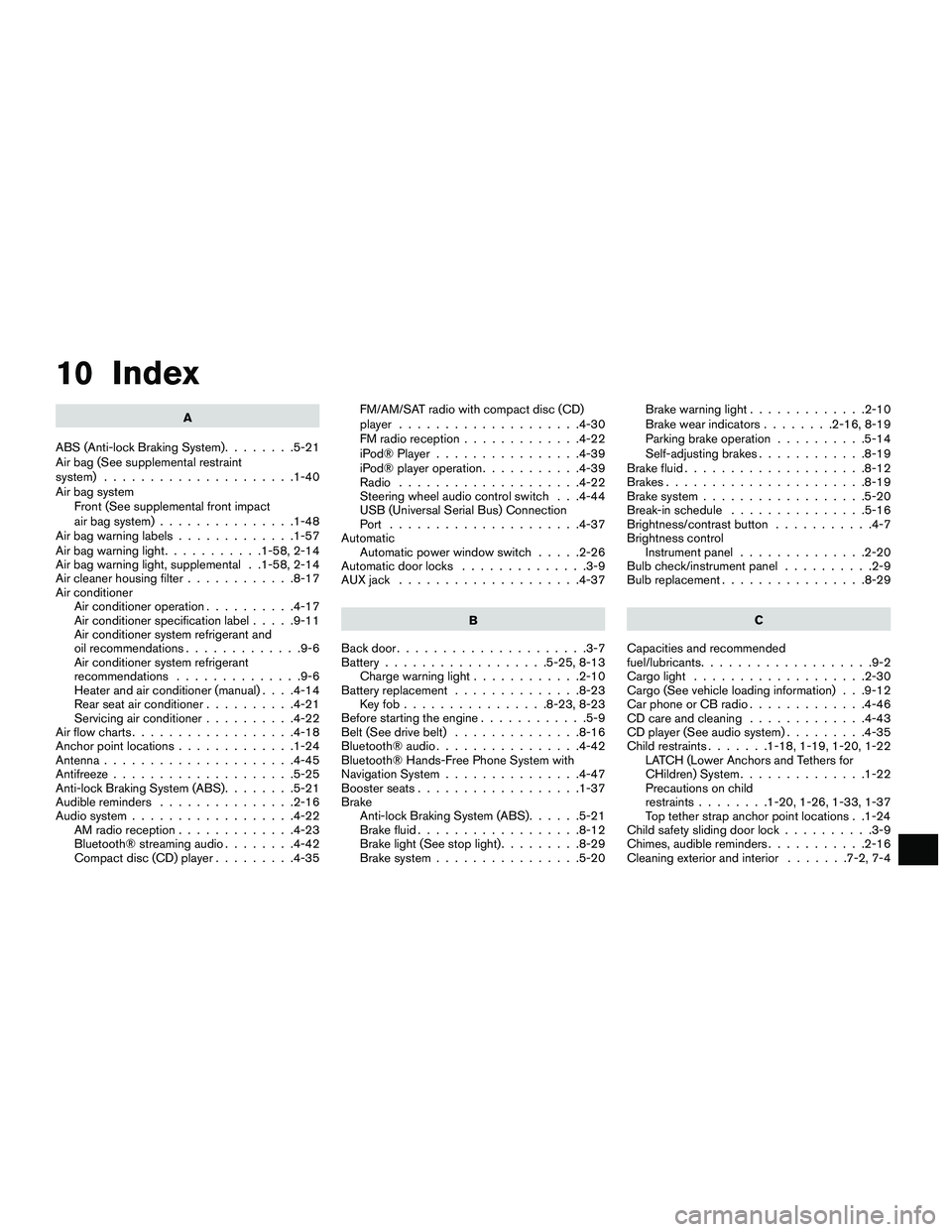
10 Index
A
ABS (Anti-lock Braking System) ........5-21
Air bag (See supplemental restraint
system) .....................1-40
Air bag system Front (See supplemental front impact
air bag system) ...............1-48
Airbagwarninglabels.............1-57
Airbagwarninglight...........1-58,2-14
Air bag warning light, supplemental . .1-58, 2-14
Air cleaner housing filter ............8-17
Air conditioner Air conditioner operation ..........4-17
Air conditioner specification label .....9-11
Air conditioner system refrigerant and
oil recommendations .............9-6
Air conditioner system refrigerant
recommendations ..............9-6
Heater and air conditioner (manual) ....4-14
Rear seat air conditioner ..........4-21
Servicing air conditioner ..........4-22
Airflowcharts..................4-18
Anchor point locations .............1-24
Antenna .....................4-45
Antifreeze ....................5-25
Anti-lock Braking System (ABS) ........5-21
Audible reminders ...............2-16
Audio system ..................4-22
AM radio reception .............4-23
Bluetooth® streaming audio ........4-42
Compact disc (CD) player .........4-35 FM/AM/SAT radio with compact disc (CD)
player ....................4-30
FMradioreception.............4-22
iPod® Player
................4-39
iPod® player operation ...........4-39
Radio ....................4-22
Steering wheel audio control switch . . .4-44
USB (Universal Serial Bus) Connection
Port .....................4-37
Automatic Automatic power window switch .....2-26
Automatic door locks ..............3-9
AUXjack ....................4-37
B
Back door .....................3-7
Battery ..................5-25,8-13
Chargewarninglight............2-10
Battery replacement ..............8-23
Keyfob................8-23,8-23
Before starting the engine ............5-9
Belt (See drive belt) ..............8-16
Bluetooth®audio................4-42
Bluetooth® Hands-Free Phone System with
NavigationSystem...............4-47
Boosterseats..................1-37
Brake Anti-lock Braking System (ABS) ......5-21
Brake fluid ..................8-12
Brake light (See stop light) .........8-29
Brake system ................5-20 Brakewarninglight.............2-10
Brakewearindicators........2-16,8-19
Parking brake operation
..........5-14
Self-adjusting brakes ............8-19
Brake fluid ....................8-12
Brakes ......................8-19
Brake system ..................5-20
Break-inschedule ...............5-16
Brightness/contrast button ...........4-7
Brightness control Instrument panel ..............2-20
Bulb check/instrument panel ..........2-9
Bulbreplacement................8-29
C
Capacities and recommended
fuel/lubricants ...................9-2
Cargolight ...................2-30
Cargo (See vehicle loading information) . . .9-12
Car
phone or CB radio .............4-46
CDcareandcleaning .............4-43
CD player (See audio system) .........4-35
Child restraints .......1-18,1-19,1-20,1-22
LATCH (Lower Anchors and Tethers for
CHildren) System ..............1-22
Precautions on child
restraints ........1-20,1-26,1-33,1-37
Top tether strap anchor point locations . .1-24
Child safety sliding door lock ..........3-9
Chimes, audible reminders ...........2-16
Cleaning exterior and interior .......7-2,7-4
Page 305 of 312

Clock setting
(models with Navigation System).....4-5,4-32
Cold weather driving ...............5-25
Compact disc (CD) player ...........4-35
Connect phone .................4-45
Continuously Variable Transmission (CVT) . . .5-10 Continuously Variable Transmission (CVT)
fluid ......................8-12
Driving with Continuously Variable
Transmission (CVT) .............5-10
Control panel buttons ...............4-2
Brightness/contrast button ..........4-7
Enterbutton..................4-2
Setting button .................4-5
Controls Audiocontrols(steeringwheel).......4-44
Rear seat air conditioner ..........4-21
Coolant Capacities and recommended
fuel/lubricants .................9-2
Changing engine coolant ...........8-8
Checking engine coolant level ........8-8
Corrosionprotection ...............7-5
Cruisecontrol..................5-15
Cupholders...................2-24
D
Defroster switch Rear window and outside mirror defroster
switch.....................2-19
Dimensionsandweights.............9-8
Dimmer switch for instrument panel ......2-20
Display controls (see control panel buttons) . .4-2
Door locks .....................3-3 Door open warning light
.............2-11
Doors ........................3-3
Drive belt .....................8-16
Driving Cold weather driving .............5-25
Driving with Continuously Variable
Transmission (CVT) .............5-10
Precautions when starting and driving ....5-2
Driving the vehicle ................5-10
E
Economy - fuel ..................5-18
Emission control information label .......9-11
Emission control system warranty .......9-17
Engine Before starting the engine ..........5-9
Capacities and recommended
fuel/lubricants .................9-2
Changingenginecoolant...........8-8
Changingengineoil.............8-10
Changing engine oil filter ..........8-11
Checking engine coolant level ........8-8
Checking engine oil level ...........8-9
Engine compartment check locations ....8-6
Engine cooling system ............8-7
Engineoil ...................8-9
Engine oil and oil filter recommendation . . .9-5
Engine oil pressure warning light ......2-11
Engine oil viscosity ..............9-5
Engine serial number ............9-10
Engine specifications .............9-7
Starting the engine ..............5-9
Enterbutton....................4-2
EventDatarecorders..............9-18 Exhaust gas (Carbon monoxide)
.........5-2
Explanation of maintenance items ........8-2
Extended storage switch ............8-22
F
Flashers (See hazard warning flasher switch) . .6-2
Flat tire .......................6-2
Floor mat positioning aid .............7-5
Fluid Brake fluid ..................8-12
Capacities
and recommended
fuel/lubricants.................9-2
Continuously Variable Transmission (CVT)
fluid......................8-12
Enginecoolant.................8-7
Engineoil ...................8-9
Windshield-washer fluid ...........8-13
F.M.V.S.S. certification label ...........9-10
Front air bag system
(See supplemental restraint system) ......1-48
Frontseats.....................1-2
Fuel Capacities and recommended
fuel/lubricants.................9-2
Fuel economy ................5-18
Fuel-filler cap .................3-14
Fuel-filler door lock opener lever ......3-14
Fuel-filler lid .................3-14
Fuelgauge...................2-6
Fuel octane rating ...............9-4
Loose fuel cap warning ............2-5
Fuel Cell Vehicle (FCV) System Tire pressure .................8-33
Fuel-filler door ..................3-14
10-2
Page 307 of 312
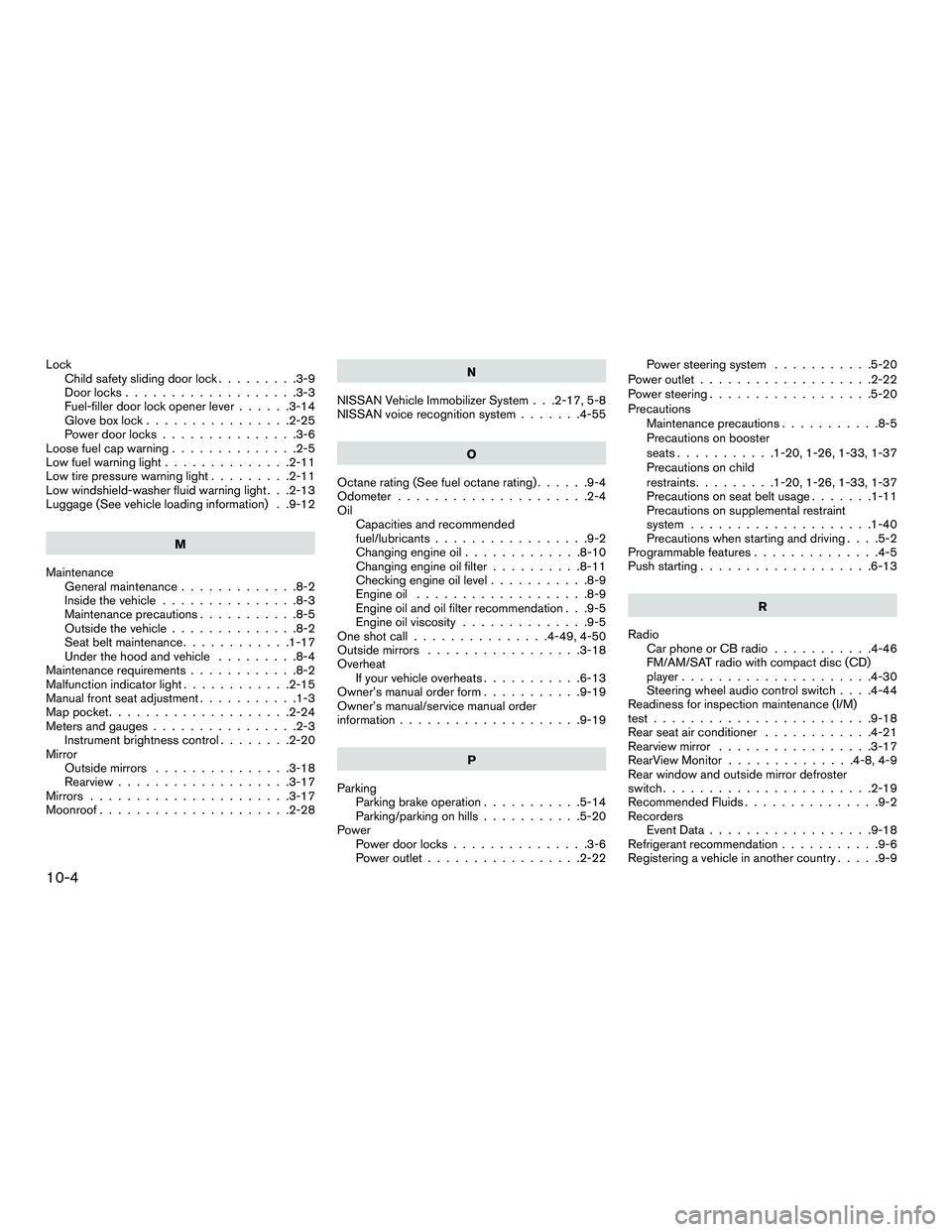
LockChild safety sliding door lock .........3-9
Door locks ...................3-3
Fuel-filler door lock opener lever ......3-14
Gloveboxlock................2-25
Power door locks ...............3-6
Loose fuel cap warning ..............2-5
Lowfuelwarninglight..............2-11
Low tire pressure warning light .........2-11
Low windshield-washer fluid warning light . . .2-13
Luggage (See vehicle loading information) . .9-12
M
Maintenance Generalmaintenance.............8-2
Insidethevehicle...............8-3
Maintenanceprecautions...........8-5
Outsidethevehicle..............8-2
Seat belt maintenance ............1-17
Under the hood and vehicle .........8-4
Maintenance requirements ............8-2
Malfunctionindicatorlight............2-15
Manual front seat adjustment ...........1-3
Map pocket ....................2-24
Meters and gauges ................2-3
Instrument brightness control ........2-20
Mirror Outside mirrors ...............3-18
Rearview ...................3-17
Mirrors ......................3-17
Moonroof.....................2-28 N
NISSAN Vehicle Immobilizer System . . .2-17, 5-8
NISSAN voice recognition system .......4-55
O
Octane rating (See fuel octane rating) ......9-4
Odometer .....................2-4
Oil Capacities and recommended
fuel/lubricants .................9-2
Changingengineoil.............8-10
Changing engine oil filter ..........8-11
Checking engine oil level ...........8-9
Engineoil ...................8-9
Engine oil and oil filter recommendation . . .9-5
Engine oil viscosity ..............9-5
Oneshotcall...............4-49,4-50
Outside mirrors .................3-18
Overheat If your vehicle overheats ...........6-13
Owner’s manual order form ...........9-19
Owner’s manual/service manual order
information ....................9-19
P
Parking Parking brake operation ...........5-14
Parking/parking on hills ...........5-20
Power Power door locks ...............3-6
Power outlet .................2-22 Power steering system
...........5-20
Poweroutlet...................2-22
Power steering ..................5-20
Precautions Maintenance precautions ...........8-5
Precautions on booster
seats...........1-20,1-26,1-33,1-37
Precautions on child
restraints .........1-20,1-26,1-33,1-37
Precautionsonseatbeltusage.......1-11
Precautions on supplemental restraint
system ....................1-40
Precautions when starting and driving ....5-2
Programmable features ..............4-5
Push starting ...................6-13
R
Radio CarphoneorCBradio ...........4-46
FM/AM/SAT radio with compact disc (CD)
player.....................4-30
Steering wheel audio control switch ....4-44
Readiness for inspection maintenance (I/M)
test........................9-18
Rear seat air conditioner ............4-21
Rearview mirror .................3-17
RearView
Monitor ..............4-8,4-9
Rear window and outside mirror defroster
switch.......................2-19
Recommended Fluids ...............9-2
Recorders EventData..................9-18
Refrigerant recommendation ...........9-6
Registering a vehicle in another country .....9-9
10-4
Page 311 of 312
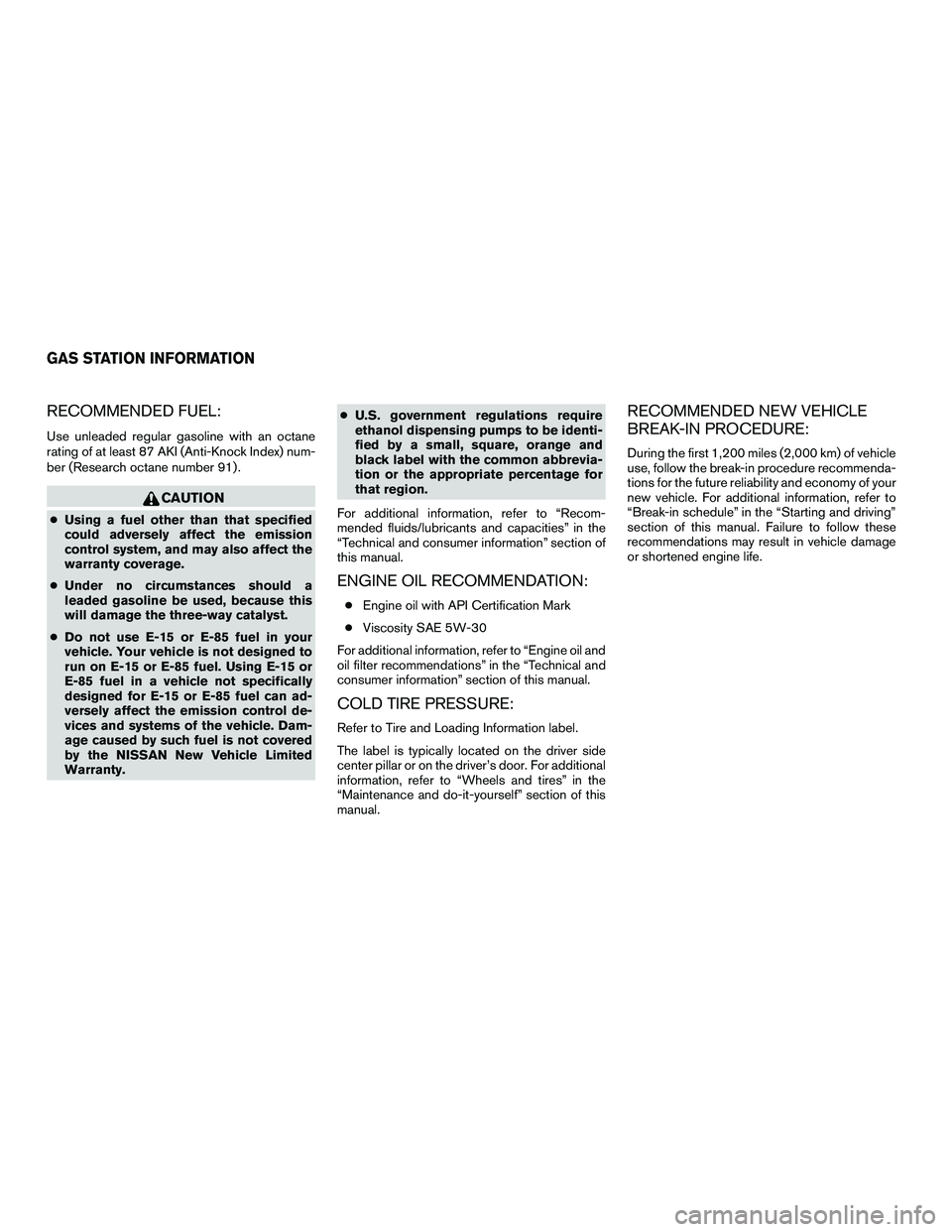
RECOMMENDED FUEL:
Use unleaded regular gasoline with an octane
rating of at least 87 AKI (Anti-Knock Index) num-
ber (Research octane number 91) .
CAUTION
●Using a fuel other than that specified
could adversely affect the emission
control system, and may also affect the
warranty coverage.
● Under no circumstances should a
leaded gasoline be used, because this
will damage the three-way catalyst.
● Do not use E-15 or E-85 fuel in your
vehicle. Your vehicle is not designed to
run on E-15 or E-85 fuel. Using E-15 or
E-85 fuel in a vehicle not specifically
designed for E-15 or E-85 fuel can ad-
versely affect the emission control de-
vices and systems of the vehicle. Dam-
age caused by such fuel is not covered
by the NISSAN New Vehicle Limited
Warranty. ●
U.S. government regulations require
ethanol dispensing pumps to be identi-
fied by a small, square, orange and
black label with the common abbrevia-
tion or the appropriate percentage for
that region.
For additional information, refer to “Recom-
mended fluids/lubricants and capacities” in the
“Technical and consumer information” section of
this manual.
ENGINE OIL RECOMMENDATION:
● Engine oil with API Certification Mark
● Viscosity SAE 5W-30
For additional information, refer to “Engine oil and
oil filter recommendations” in the “Technical and
consumer information” section of this manual.
COLD TIRE PRESSURE:
Refer to Tire and Loading Information label.
The label is typically located on the driver side
center pillar or on the driver’s door. For additional
information, refer to “Wheels and tires” in the
“Maintenance and do-it-yourself” section of this
manual.
RECOMMENDED NEW VEHICLE
BREAK-IN PROCEDURE:
During the first 1,200 miles (2,000 km) of vehicle
use, follow the break-in procedure recommenda-
tions for the future reliability and economy of your
new vehicle. For additional information, refer to
“Break-in schedule” in the “Starting and driving”
section of this manual. Failure to follow these
recommendations may result in vehicle damage
or shortened engine life.
GAS STATION INFORMATION